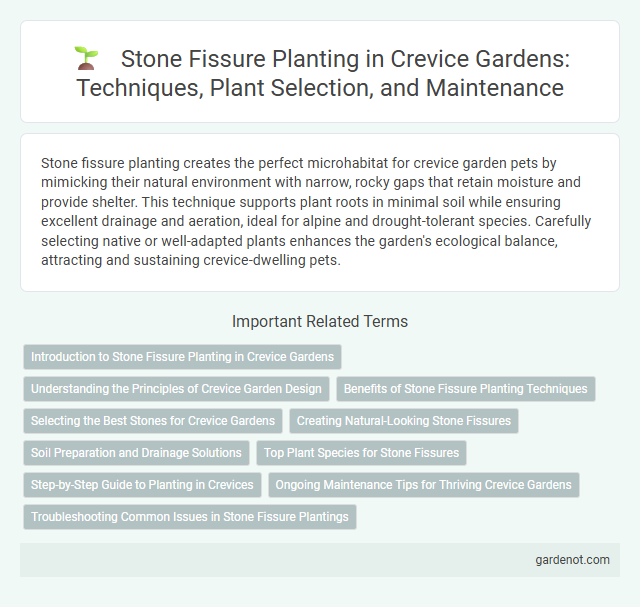Stone fissure planting creates the perfect microhabitat for crevice garden pets by mimicking their natural environment with narrow, rocky gaps that retain moisture and provide shelter. This technique supports plant roots in minimal soil while ensuring excellent drainage and aeration, ideal for alpine and drought-tolerant species. Carefully selecting native or well-adapted plants enhances the garden's ecological balance, attracting and sustaining crevice-dwelling pets.
Introduction to Stone Fissure Planting in Crevice Gardens
Stone fissure planting in crevice gardens involves utilizing narrow gaps and cracks between rocks to create natural microhabitats ideal for alpine and drought-tolerant plants. These fissures retain moisture while providing excellent drainage, mimicking mountainous environments critical for species like saxifrages and sedums. This technique enhances biodiversity and offers a sustainable solution for ornamental gardening in rocky landscapes.
Understanding the Principles of Crevice Garden Design
Stone fissure planting in crevice garden design maximizes plant growth by mimicking natural rock formations, creating narrow gaps filled with well-draining soil ideal for alpine and drought-tolerant species. Key principles include selecting appropriate stone types such as sandstone or limestone, ensuring fissures with varied depths and widths to accommodate diverse root systems, and orienting crevices to optimize sunlight exposure and moisture retention. Proper layering of stones enhances stability while promoting microhabitats, resulting in a sustainable, visually striking landscape that supports unique plant biodiversity.
Benefits of Stone Fissure Planting Techniques
Stone fissure planting enhances root anchorage by utilizing natural cracks in rocks, promoting better stability and growth in challenging environments. This technique boosts water retention and nutrient access, supporting drought-resistant and slow-growing plant species. It also reduces soil erosion and maintenance needs, making it ideal for sustainable and low-impact gardening in crevice gardens.
Selecting the Best Stones for Crevice Gardens
Selecting the best stones for crevice gardens involves choosing durable, weather-resistant materials like sandstone, limestone, or slate that provide natural fissures for planting. Stones should have rough textures and irregular shapes to create deep crevices, enhancing root anchorage and moisture retention. Positioning heavier stones at the base ensures stability, while layering varied sizes mimics natural rock formations, promoting healthy plant growth in stone fissures.
Creating Natural-Looking Stone Fissures
Creating natural-looking stone fissures in crevice gardens involves carefully selecting flat, layered stones such as sandstone or slate to mimic natural rock formations. Stones are positioned with intentional gaps and irregular edges to form deep crevices that retain moisture and provide ideal microhabitats for alpine and rock garden plants. Incorporating soil and planting drought-tolerant species like saxifrages and sedums within these fissures enhances the authenticity and ecological function of the stone fissure planting.
Soil Preparation and Drainage Solutions
Stone fissure planting in crevice gardens requires meticulously prepared soil to ensure optimal root growth and moisture retention. Incorporating a well-draining soil mix composed of gritty sand, organic matter, and small gravel prevents waterlogging and promotes healthy plant development. Effective drainage solutions, such as layered substrates and strategically placed drainage holes, mitigate excess moisture and replicate natural crevice environments for alpine or drought-tolerant species.
Top Plant Species for Stone Fissures
Sedum species are ideal for stone fissure planting due to their drought tolerance and shallow root systems, thriving in minimal soil within narrow crevices. Saxifraga, known for its compact rosettes and alpine origins, excels in maintaining moisture and adding texture to crevice gardens. Additionally, thyme varieties contribute aromatic foliage and resilience, making them top choices for enhancing stone fissure biodiversity and aesthetics.
Step-by-Step Guide to Planting in Crevices
Planting in crevices involves selecting hardy, drought-tolerant plants such as sedums, sempervivums, or alpine species that thrive in minimal soil and harsh conditions. First, clean and widen crevices to ensure adequate depth and drainage, then carefully insert soil mix tailored for good aeration and moisture retention. Firmly plant cuttings or seedlings into the crevice, pressing soil around roots to eliminate air pockets, and water sparingly to establish roots without causing rot.
Ongoing Maintenance Tips for Thriving Crevice Gardens
Stone fissure planting in crevice gardens requires regular monitoring to prevent debris buildup and ensure optimal drainage, promoting healthy root growth. Maintaining consistent moisture levels while avoiding waterlogging is crucial, as is periodic inspection for pests and diseases to address issues promptly. Mulching with small gravel around fissures helps retain humidity and stabilize temperature, enhancing plant resilience in these unique microhabitats.
Troubleshooting Common Issues in Stone Fissure Plantings
Stone fissure plantings often face challenges such as poor drainage, root rot, and limited nutrient availability due to compacted or shallow soil within crevices. To troubleshoot these issues, ensure fissures are adequately filled with well-draining, nutrient-rich substrate and select drought-tolerant, shallow-rooted plants adapted to rocky environments. Regular monitoring for signs of water stress or fungal infections and adjusting watering schedules can improve plant health in stone fissure gardens.
Stone fissure planting Infographic

 gardenot.com
gardenot.com